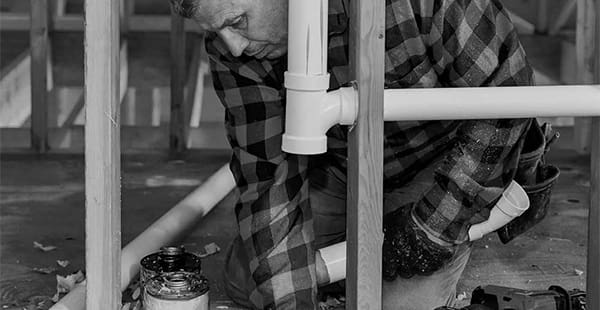01. Asbestos Risk
How Are Plumbers Exposed to Asbestos?
Plumbers and pipefitters may encounter asbestos in older plumbing materials. The plumbing industry used asbestos in many products, like pipe insulation, cement pipes and adhesives. These asbestos products can become dangerous when they are damaged or worn.
The industry manufactured and used these products from the 1920s to the 1980s. The products often needed heat resistance and durability. Asbestos provided these traits, and it was readily available.
Some common plumbing tasks can also release asbestos fibers. Once the fibers become airborne, they can be inhaled and cause serious illnesses.
Many plumbers frequently faced occupational exposure because asbestos was so common. For decades, the dangers of asbestos were not widely known. But the Environmental Protection Agency (EPA) began to take action in the 1970s. It created laws and regulations to help protect plumbers and other workers from asbestos.
By the 1980s, asbestos manufacturing declined. However, asbestos-containing pipes are still present in many older buildings. As a result, some plumbers may still be exposed from lingering asbestos materials.
What Asbestos Products Put Plumbers at Risk?
Many plumbing products contained asbestos. Plumbers often repair plumbing in older buildings. Plumbers may have encountered asbestos insulation, gaskets and valves in these buildings. They may sometimes also need to cut through other construction materials that contain asbestos. These interactions with products and materials may pose a risk of asbestos exposure.
When plumbers cut, sand or saw older materials that contain asbestos, the fibers can be released into the air. When asbestos fibers are airborne, they become dangerous because plumbers can then inhale the asbestos fibers.
Some products plumbers may have used include:
- Asbestos adhesives
- Asbestos cement
- Asbestos paper
- Block insulation
- Gaskets
- Joint compounds
- Pipe coatings
- Thermal insulation
- Valves
- Welding rods
Many companies manufactured and sold asbestos-containing products. Some of these businesses knew about the health risks of asbestos. These companies put plumbers’ safety at risk. As a result, asbestos companies now face lawsuits from exposure victims.
The EPA issued a final rule in 2024 that banned ongoing uses of chrysotile asbestos. Before this, the United States restricted some uses while others remained permitted. As a result, plumbers face a continued exposure risk from asbestos products.
Common Places Plumbers May Find Asbestos
Workers in the plumbing industry work at many different jobsites. Plumbers often work at industrial or residential sites.
Locations that often expose plumbers include:
- Homes
- Industrial facilities
- Power plants
- Residential buildings
- Schools
- Water treatment plants
Plumbers regularly work in boiler rooms and other poorly ventilated areas. Without proper ventilation, these areas may pose more risk than others. In some cases, employers have not supplied the right protective equipment. These conditions may put workers at a higher risk of asbestos exposure.
Plumbers and At-Risk Trades
Besides plumbers, others in the plumbing industry face asbestos exposure risks. For example, pipefitters and steamfitters also worked with asbestos products.
Pipefitters and steamfitters often cut asbestos insulation. They may also drill other products to fit on pipes. Cutting, sanding and sawing these products can release asbestos into the air. These workers and anyone else on the jobsite may face asbestos exposure risks.
Today, plumbers, pipefitters and steamfitters should not attempt to remove asbestos-containing materials. Improper asbestos removal may lead to exposure. Only asbestos abatement professionals should remove or dispose of asbestos. They have specific training and licensing to ensure they can handle asbestos safely.
02. Mesothelioma Risk
Mesothelioma Risk for Plumbers
Plumbers may have a higher risk of asbestos exposure than the general population. Anyone exposed to asbestos may develop asbestosis, lung cancer or mesothelioma. Several studies have found links between plumbing work and these asbestos illnesses.
In one study, researchers reviewed the health records of plumbers and pipefitters. These records included imaging scans of the participants’ lungs. Compared to telephone workers, plumbers and pipefitters had 10 times the rate of pleural thickening. Pleural thickening can be a precursor to mesothelioma.
In another study, plumbers wore devices to measure how often they encountered asbestos on the job. The devices showed about 60% of the plumbers had been exposed while at work. Those with the highest exposures had worked in an area recently stripped of asbestos. This information suggests lax asbestos removal and cleanup can put plumbers at risk. And they may be unaware of this risk when the exposure happens.
Plumbers with known asbestos exposure should maintain regular doctor appointments and cancer screenings. Mesothelioma and other asbestos diseases may take decades to appear after initial exposure. This means plumbers exposed in the past may still develop a related disease. So it is important that plumbers share any history of asbestos exposure with their doctors.
03. Compensation
Compensation for Plumbers With Occupational Asbestos Exposure
Plumbers exposed to asbestos on the job may be eligible for financial compensation if diagnosed with mesothelioma. Mesothelioma attorneys can help victims and their loved ones understand their legal options.
On behalf of their clients, attorneys can also build cases and file lawsuits within the legal deadline. Legal deadlines, or statutes of limitations, may differ from state to state. Successful mesothelioma lawsuits may result in compensation from a settlement or jury award.
One example of a successful lawsuit involved a man who had worked as a plumber and a mechanic. He developed pleural mesothelioma after retiring. The California jury awarded him $2.07 million in economic and non-economic damages.
Some mesothelioma settlement examples include:
- $13.4 million for a 55-year-old plumber
- $5.4 million for a 64-year-old pipefitter
- $2.9 million for a 61-year-old steamfitter
Some plumbers diagnosed with asbestos-related diseases may qualify for other types of compensation. One option is a claim against an asbestos trust. Compensation may help patients and their families cover medical expenses and other costs.




